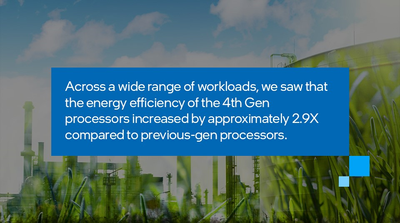
Energy Efficiency, Sustainability, and Intel®
At Intel, we approach our goal of reducing impact on greenhouse gas emissions and the environment through several avenues. While we continue working toward our own goal of net-zero emissions by 2040 (scope 1 and 2), we also work with governments, peers, and nonprofits to help combat climate change. Some of our initiatives include collaborating with other semiconductor manufacturers to reduce emissions for the entire industry while finding more ways to use our technology to lower the climate impact of global manufacturing. We’re also aiming to achieve net zero upstream Scope 3 greenhouse gas emissions by 2050, use 100% renewable electricity by 2040 and conserve 60 billion gallons of water by 2030. For more information about these and other efforts we’re making to help improve our environment, read our full report here.
One of our 2030 goals is increasing our processor efficiency ten-fold to reduce Scope 3 emissions.[3] With 4th Gen Intel® Xeon® Scalable processors, we continue to make strides toward that objective. 4th Gen Intel Xeon Scalable processors achieved approximately 29% improvement in energy efficiency over 3rd Generation Intel Xeon Scalable processors using top-bin SKUs as measured by industry benchmark SPEC® SERT.®[4]The efficiency gain was largely driven by higher core count, microarchitecture improvements, support for DDR5 memory, and PCIe Gen 5. Across a wide range of workloads, we saw that the energy efficiency of the 4th Gen processors increased by approximately 2.9X compared to previous-gen processors.5 With AI inference workloads, 4th Gen Intel Xeon processors enabled up to 14X greater performance per watt.[5]
Performance and Efficiency in the Cloud: ~2x faster with 50% less emissions
The Google Cloud C3 instance family, released in private preview in October 2022 and generally available since May 2023, was the first public cloud instance type available with the more energy-efficient 4th Gen Intel® Xeon® Scalable processors. For these instances, we collaborated with Google to co-design an ASIC Infrastructure Processing Unit (IPU). This IPU allows the CPUs to offload packet processing for the IPU to handle, leaving more CPU power for your workloads. The IPU also allows Google to provide 200Gbps networking for C3 instances and line-rate encryption.[6]
So, how does that translate into actual workload performance? To answer that, let’s look at testing using AI inference workloads and workloads running on distributed databases.
To highlight the advantages of using the C3 instance with 4th Gen Intel® Xeon® Scalable processors for AI inference, Datatonic conducted testing comparing it to the older N2 instance.[7] On a ResNet model, the C3 instance reduced time to complete by 42.9% and decreased CO² emissions by 53.0%. In inference testing using a BERT model, the improvement with the C3 instance was even greater, cutting time to complete by 56.6% and CO² emissions by 57.7%.
To quantify the benefits of upgrading from N2 instances with older processors to the C3 instance family for workloads running on distributed databases, Intel tested on MongoDB and Redis. We ran MongoDB workloads on all three types of Google Cloud instances: standard, high-cpu, and high-memory, using four different read/write ratios to reflect different database behaviors. Across all instance types and all workload types, the C3 instances outperformed the N2 instances, delivering as much as 1.40 times the maximum throughput.[8] Our Redis testing compared the c3-highcpu-4 instance with 8GB of memory to the n2-standard-4 instance with 16GB of memory. With only half the memory of the older N2 instance, the C3 instance achieved 1.23 times as many operations per second.[9] Doing more work in less time translates not only to savings, but also to conserving energy and improving sustainability.
Conclusion
Technology plays an important role in helping the world be more sustainable through greater energy efficiency. Intel® is committed to manufacturing products more sustainably and also increasing the energy efficiency of our products in use. Intel is proud to partner with other industry leaders, such as Google, to bring more energy efficient solutions to life. With Google Cloud and its C3 instance powered by 4th Gen Intel Xeon processors, customers will be able to achieve improved performance while also conserving energy and reducing emissions. Meeting performance demands and providing sustainability benefits – now that’s a winning solution.
[1] https://csrreportbuilder.intel.com/pdfbuilder/pdfs/CSR-2022-23-Full-Report.pdf
[2] https://edc.intel.com/content/www/us/en/products/performance/benchmarks/4th-generation-intel-xeon-scalable-processors/ [Claim E1]
[3] https://csrreportbuilder.intel.com/pdfbuilder/pdfs/CSR-2022-23-Full-Report.pdf [page 75]
[5] https://csrreportbuilder.intel.com/pdfbuilder/pdfs/CSR-2022-23-Full-Report.pdf [page 74]
[6] https://cloud.google.com/blog/products/compute/introducing-c3-machines-with-googles-custom-intel-ipu
[7] https://datatonic.com/insights/reducing-carbon-impact-ai-inferencing-intel-google-cloud/
You must be a registered user to add a comment. If you've already registered, sign in. Otherwise, register and sign in.

